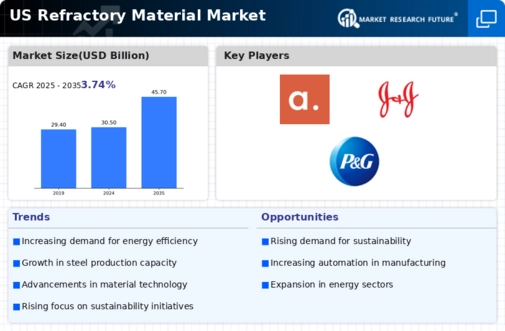The refractory material market exhibits a dynamic competitive landscape characterized by a blend of innovation, strategic partnerships, and regional expansion. Key players such as HarbisonWalker International (US), RHI Magnesita (AT), and Vesuvius (GB) are actively shaping the market through their distinct operational focuses. HarbisonWalker International (US) emphasizes local manufacturing and supply chain optimization, which enhances its responsiveness to customer needs. RHI Magnesita (AT) appears to be concentrating on digital transformation initiatives, aiming to streamline operations and improve product offerings. Vesuvius (GB) is likely leveraging its expertise in advanced materials to drive innovation, thereby positioning itself as a leader in high-performance refractory solutions. Collectively, these strategies contribute to a moderately fragmented market structure, where competition is intensified by the diverse approaches of these key players.
In terms of business tactics, companies are increasingly localizing manufacturing to reduce lead times and enhance supply chain efficiency. This trend is particularly evident in the operations of HarbisonWalker International (US), which has been optimizing its supply chain to better serve its North American clientele. The competitive structure of the market remains moderately fragmented, with several players vying for market share. However, the influence of major companies is substantial, as they set benchmarks for quality and innovation that smaller firms strive to meet.
In October 2025, RHI Magnesita (AT) announced a strategic partnership with a leading technology firm to develop AI-driven solutions for refractory material production. This move is significant as it underscores the company's commitment to integrating advanced technologies into its manufacturing processes, potentially enhancing efficiency and product quality. The partnership may also position RHI Magnesita at the forefront of digital innovation within the industry, allowing it to respond more adeptly to market demands.
In September 2025, Vesuvius (GB) launched a new line of eco-friendly refractory materials aimed at reducing environmental impact. This initiative reflects a growing trend towards sustainability in the industry, as companies seek to align their operations with global environmental standards. By prioritizing sustainable practices, Vesuvius not only addresses regulatory pressures but also appeals to a market increasingly concerned with environmental responsibility.
In August 2025, HarbisonWalker International (US) expanded its manufacturing capabilities by investing in a new facility in the Midwest. This expansion is likely to enhance the company's production capacity and improve its ability to meet regional demand. Such strategic investments indicate a proactive approach to market growth, positioning HarbisonWalker as a formidable competitor in the refractory material sector.
As of November 2025, the competitive trends in the refractory material market are increasingly defined by digitalization, sustainability, and the integration of AI technologies. Strategic alliances are becoming more prevalent, as companies recognize the value of collaboration in driving innovation and enhancing operational efficiency. Looking ahead, it appears that competitive differentiation will evolve from traditional price-based competition to a focus on technological advancements, sustainable practices, and reliable supply chains. This shift may redefine the competitive landscape, compelling companies to innovate continuously to maintain their market positions.














Leave a Comment